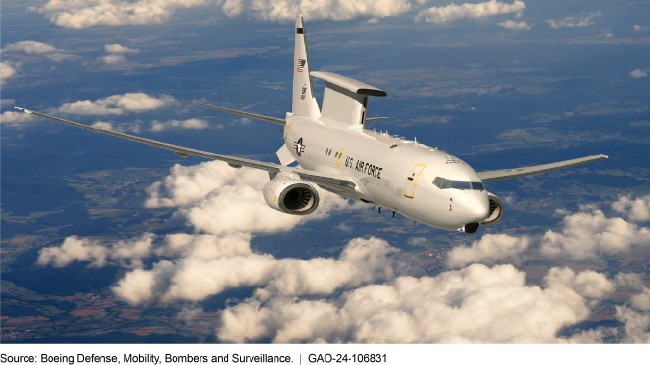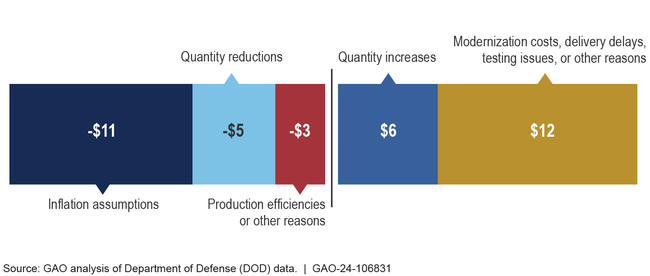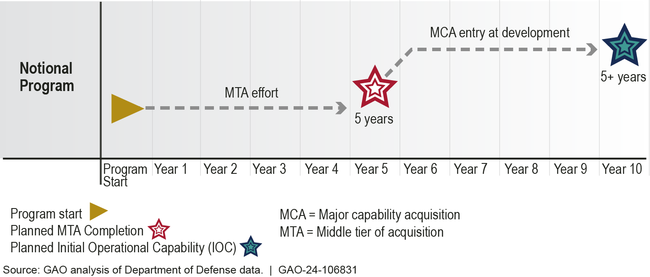Weapon Systems Annual Assessment: DOD Is Not Yet Well-Positioned to Field Systems with Speed [Reissued with revisions on Jul. 18, 2024]
Fast Facts
Our 22nd annual assessment of DOD's weapon systems acquisition finds DOD still struggling to deliver new technologies quickly, even while faced with constantly evolving threats.
DOD acknowledged it needed a new approach—creating acquisition pathways to speed up processes. But some programs in the new pathways likely won't deliver much faster than traditional programs.
Also, DOD only reported plans to take full advantage of leading product development practices in a few programs, even though doing so can increase speed.
We recommended that DOD document how it intends to use leading practices. Weapon systems acquisition is on our High Risk List.
The Air Force E-7A Battle Management Aircraft

Revised July 18, 2024, to update the front cover image and to correct source information for front cover images on pages 239 and 240.
Highlights
What GAO Found
While the Department of Defense (DOD) plans to invest more than $2 trillion to develop and acquire its costliest weapon programs, it continues to struggle with delivering innovative technologies quickly. Weapon systems are more complex and driven by software than ever before. Recent reforms were intended to lead to faster results, but slow, linear development approaches persist. In July 2023, GAO found that leading commercial companies deliver complex, innovative products with speed through iterative cycles of design, development, and production.
Cost and schedule performance for DOD's costliest weapon programs. Combined total estimates decreased slightly by $1.7 billion in the past year for the 31 major defense acquisition programs (MDAP) that GAO assessed in depth this year and last year. This decrease was the result of several factors, including quantity reductions and changes in inflation assumptions. However, several large programs plan to update their cost estimates because of a statutory unit cost growth breach or other program performance changes, which may result in future cost growth.
Factors That Drove 1-Year Cost Changes for 31 Major Defense Acquisition Programs (fiscal year 2024 dollars in billions)

The average MDAP that has yet to deliver initial capability plans to take over 10 years to do so—slightly longer than last year. This continues a trend of increased cycle times. GAO also found that, for MDAPs that have delivered capability, the average amount of time it took to do so increased from 8 years to 11 years—an average increase of 3 years from their original planned date.
GAO also assessed 20 of DOD's largest middle tier of acquisition (MTA) programs, with a combined estimated total cost of over $35 billion. GAO found that five MTA programs continue to report delays to a key milestone intended to demonstrate capability.
Although the MTA pathway was designed for speed, GAO found most MTA programs do not plan to implement leading practices to facilitate that speed. For example, most MTA acquisition strategies do not outline how programs plan to leverage leading practices to develop and deliver an initial fieldable capability—the goal of an iterative approach—within 5 years.
Some programs continue to expect to deliver capability after following lengthy, linear development schedules, such as 5 years for rapid prototyping followed by another development effort of 5 or more years. Employing leading practices to deliver capability with speed provides programs with an opportunity to follow an iterative approach to development.
Example of a Middle Tier of Acquisition Program Transitioning to the Major Capability Pathway at Development before Fielding Initial Capability

Software development approaches and cybersecurity practices. Since 2021, more programs have reported using modern software development approaches. But programs continued to lag in implementing key practices, such as using a software factory and modular contracting, to accelerate software development.
Most MDAP and MTA programs GAO reviewed did not consistently report scheduling key cybersecurity assessments at appropriate stages of development or before planned transition dates, respectively. Conducting such assessments early is critical to identifying and fixing vulnerabilities with less effect on program schedule. In 2023, we issued a restricted report that includes recommendations related to early cybersecurity testing.
Software workforce challenges. DOD programs have struggled to hire and retain a workforce with sufficient software expertise. Most of the 53 software-intensive programs GAO reviewed reported contractor-led software development efforts, underscoring the importance of capable acquisition staff for oversight.
Most of the 53 Software-Intensive Acquisition Programs GAO Reviewed Reported Challenges Related to Hiring and Retaining the Software Workforce

DOD has taken initial steps to establish a cadre of personnel with software expertise, but its efforts are in early stages. While DOD expects to request more funding, as of March 2024, the cadre consisted of one federal employee with limited assistance. Without planning for key aspects of how it will expand the cadre and defining the cadre's goals, DOD may face challenges providing its acquisition programs with the software acquisition expertise they need.
Why GAO Did This Study
To deliver more timely and effective solutions to the warfighter, DOD revamped its department-wide acquisition policies in 2020. These policy changes responded to long-standing concerns that the defense acquisition process was overly bureaucratic and too slow.
As part of these changes, DOD established the Adaptive Acquisition Framework, which offers a variety of pathways for acquisition programs. This framework includes the major capability acquisition pathway to acquire and modernize unique DOD programs that provide enduring capability. MDAPs, some of the costliest programs, follow the major capability pathway.
The framework also includes the MTA pathway for rapid prototyping and rapid fielding. This pathway for programs is intended to be completed in 5 years.
This report, GAO's 22nd annual assessment, responds to a provision Congress included in statute for GAO to annually review selected DOD acquisition programs and efforts. It assesses the characteristics and performance of 108 of DOD's costliest weapon programs.
It further analyzes selected programs' implementation of leading practices for product development, as described in GAO-23-106222, as well as modern software development approaches, and cybersecurity practices. Finally, it assesses DOD's efforts to address challenges related to the software acquisition workforce; including steps DOD has taken to establish a congressionally directed software cadre.
GAO identified programs for review based on cost and acquisition status; reviewed relevant legislation and policy; collected program documents; used a questionnaire to obtain data from program offices; and interviewed DOD officials.
Reissued with revisions on Jul. 18, 2024
Revised July 18, 2024, to update the front cover image and to correct source information for front cover images on pages 239 and 240.Recommendations
GAO is making three recommendations to DOD, including that DOD address how MTA programs implement leading practices for product development; define goals for its software cadre; and identify strategies and resources need to achieve those goals. DOD concurred with the software workforce recommendations and partially concurred with the remaining recommendation. DOD stated that, to facilitate effective implementation, the recommendation should be focused on updating policy rather than guidance. GAO agreed with DOD's rationale and revised its recommendation accordingly.
Recommendations for Executive Action
| Agency Affected | Recommendation | Status |
|---|---|---|
| Department of Defense | The Secretary of Defense should direct the USD(A&S) to issue policy calling for MTA program acquisition strategies to include how the program plans to implement leading practices for product development to deliver fieldable capability with speed, within 5 years. (Recommendation 1) |
When we confirm what actions the agency has taken in response to this recommendation, we will provide updated information.
|
| Department of Defense | The Secretary of Defense should ensure the USD(A&S) fully defines goals for DOD's software cadre, to include long-term outcomes and near-term measurable results with time frames. (Recommendation 2) |
When we confirm what actions the agency has taken in response to this recommendation, we will provide updated information.
|
| Department of Defense | The Secretary of Defense should ensure the USD(A&S) identifies strategies and resources needed to achieve DOD's goals for its software cadre, including assessing the internal and external factors that could affect achievement of DOD's goals for its software cadre and how to mitigate them. (Recommendation 3) |
When we confirm what actions the agency has taken in response to this recommendation, we will provide updated information.
|

